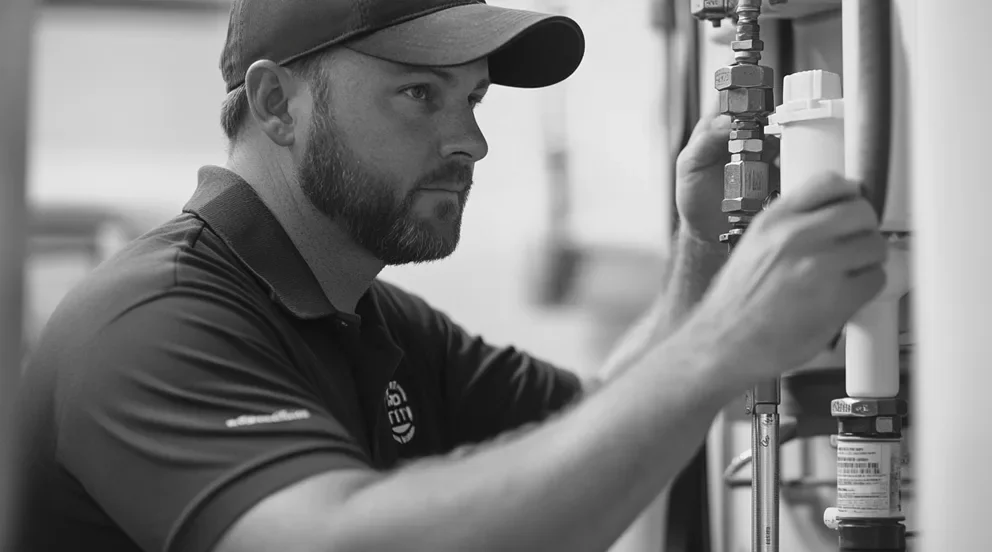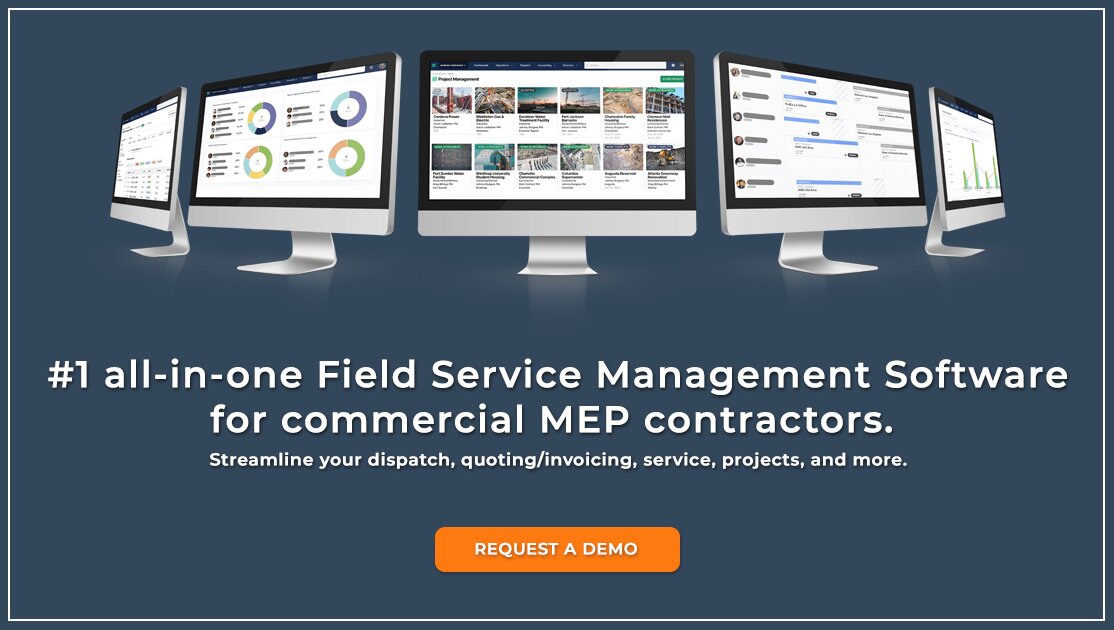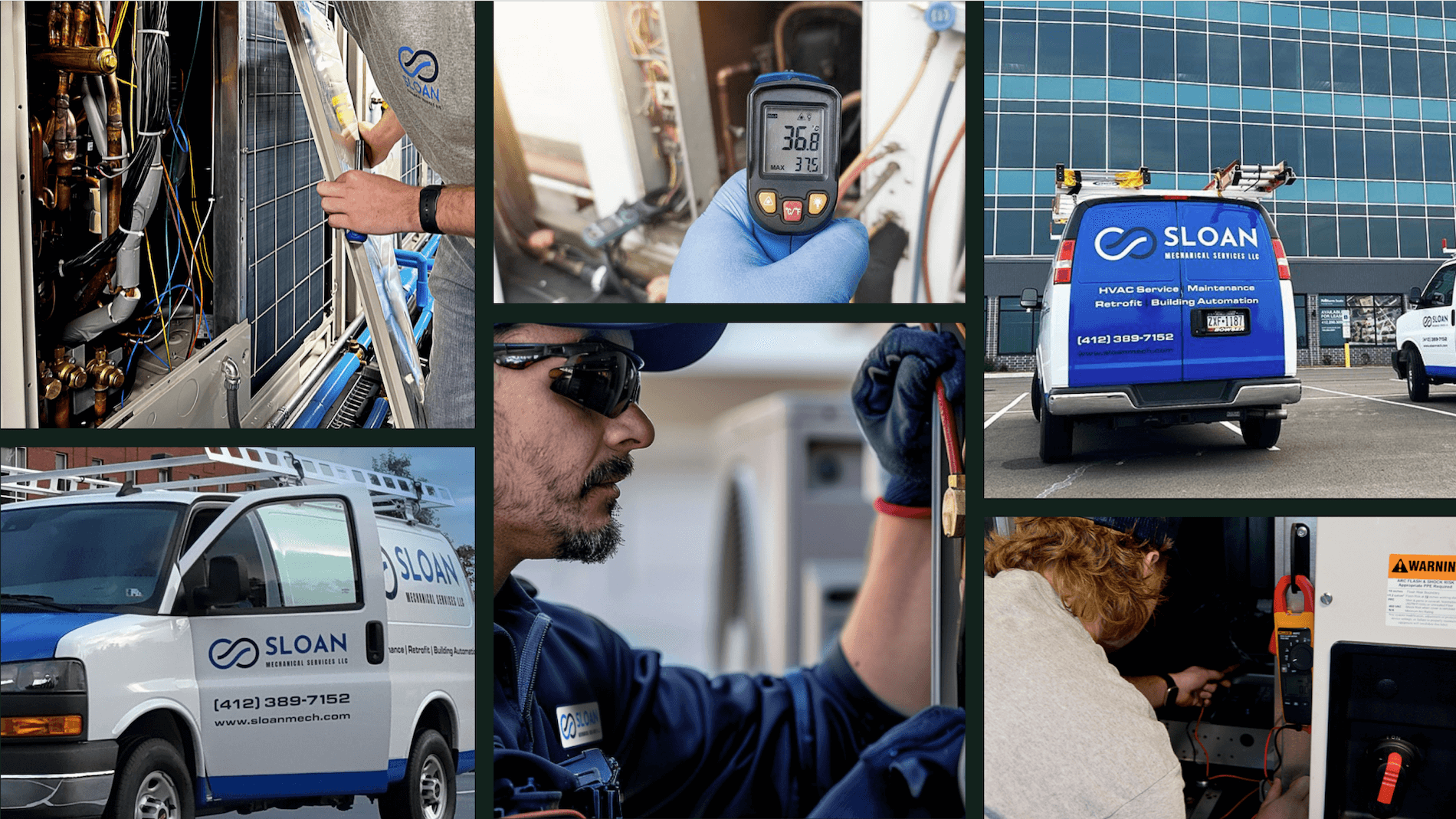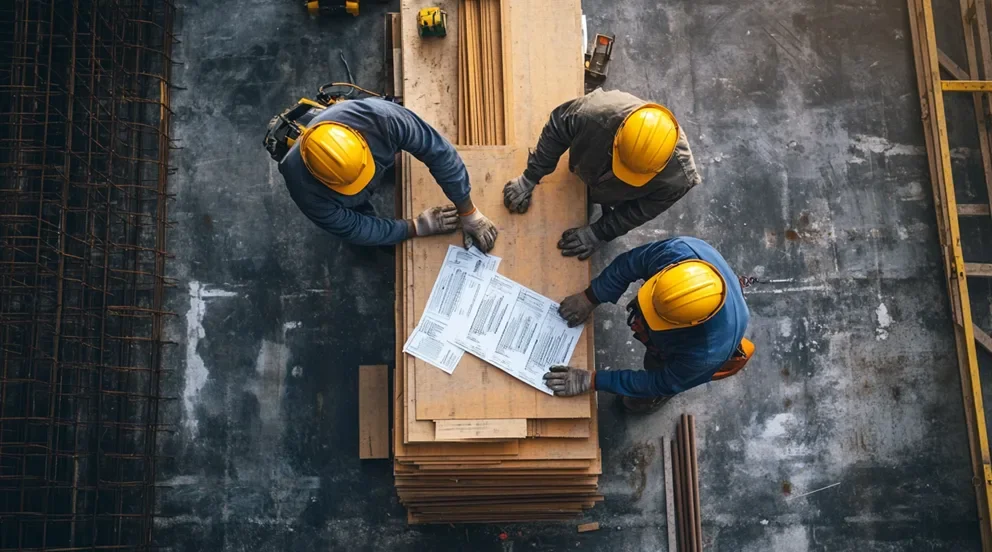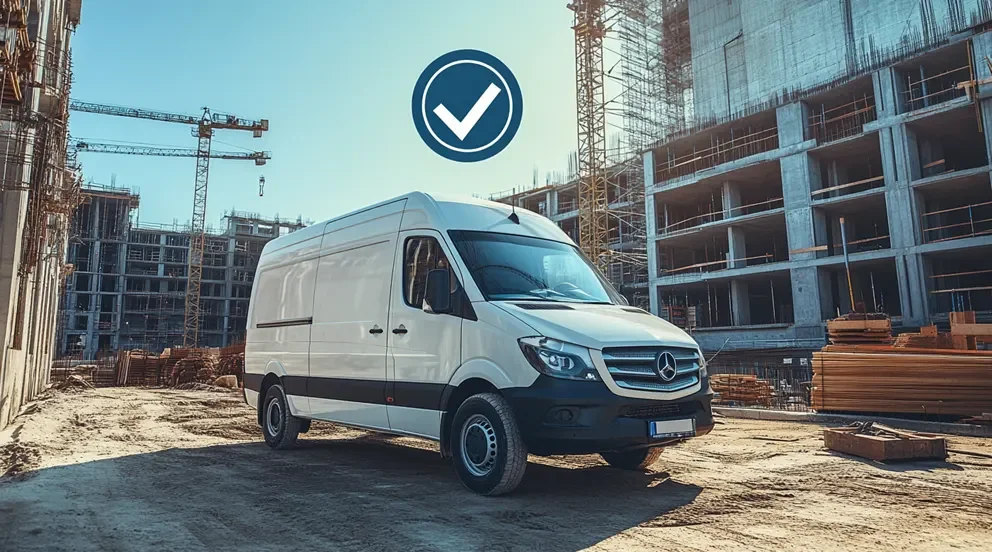Important
While BuildOps does not currently offer a plumbing flat rate pricing app, we’re always looking into new and exciting tools and technology that are moving the industry forward, which is why we’re discussing the subject here.
Plumbing teams know the challenge — every job’s different, but customers still want a set price upfront. That’s where flat rate pricing comes in. The right app can simplify quotes, keep techs consistent, and speed up billing. The wrong one? It adds more headaches.
If your crew is stuck flipping through price books or relying on memory, it might be time to upgrade. A solid plumbing flat rate pricing app helps techs quote faster, stay accurate, and move through jobs without second-guessing numbers. This guide walks through what to look for, what to avoid, and which apps actually hold up out in the field.
For contractors focused on the tools shaping the future of the plumbing industry, this guide delivers exactly what you need to make a smart call. Here’s everything we’ll cover:
- Choosing the right flat rate pricing plumbing app for your team
- Common plumbing flat rate pricing models
- Why a flat rate pricing model falls short for plumbing contractors
- 5 features to look for in a flat rate pricing app for plumbers
- 7 best flat rate pricing apps for plumbing contractors
- 6 benefits of using a flat rate pricing app as a plumber
- 4 common flat rate pricing app FAQs answered for plumbing contractors
Before diving into features, start with the basics: how your crew works and what gets in their way. That’s how you find a tool that actually helps.
Choosing the right flat rate pricing plumbing app for your team
Some apps are built for office workflows. Others actually help in the field. Before choosing a plumbing flat rate pricing app, look at how your techs quote, bill, and update pricing on the job — not just how clean the interface looks in a demo. Your app needs to work in the real world: in a truck, during a rush call, or when the Wi-Fi cuts out. You’ll find more context in this plumbing flat rate pricing guide, but here’s how to start zeroing in on what matters for your crew.
Ask your team these questions before picking a platform:
- Daily workflow fit – Does the app connect with your existing tools like invoicing, dispatching, or customer records? Can it handle jobs that span multiple days or techs?
- Usability in the field – Is the app quick to use on mobile? Can techs update pricing mid-job without calling the office or restarting the system?
- Scalability – Will it still work as your team grows? Can you control who sees what, and how pricing rules apply across different job types?
- Support and stability – What happens when something breaks? Is there live support? How often does the app update its pricing data or code libraries?
- Features – Does it support customizable price books, automatic syncing with work orders, or bundling services? Can it suggest upsells or pull in past job info?
Every app leans on a pricing model — and not all of them match how plumbers actually work. Let’s look at the most common setups and where they fit best.
Common plumbing flat rate pricing models
Before you commit to any plumbing flat rate pricing app, it’s smart to understand how different pricing models work behind the scenes. Each model changes how your techs quote in the field, how fast you can send estimates, and how confident customers feel when seeing numbers on a screen.
Here’s how the three most common models actually work for plumbers on the job:
- Flat rate – Set price, no surprises. Techs choose a job type in the app, show the customer the cost, and get sign-off before turning a wrench. It keeps things fast, avoids math on the fly, and helps everyone stay consistent. Flat rate works best when you’re dealing with repeatable tasks — like toilet swaps, valve replacements, or water heater installs — where you already know the scope.
- Time and materials – This one bills for labor hours plus parts. It's handy for jobs with unknowns, like chasing a hidden leak or opening up a slab. But it demands more from the app. Your team needs to log time, track parts, and maybe even sync notes — all without slowing down. If your app doesn’t support that in real time, it becomes a bottleneck.
- Tiered pricing – Think good-better-best packages. Some plumbing flat rate pricing apps let you show side-by-side options on a tablet — maybe a basic drain clear, a mid-level treatment, or a premium package with warranty. It’s great for upselling, but only if the app makes the tiers crystal clear for techs and customers.
Each model has its place — but when your team’s out in the field, tapping through tasks in real time, some setups make life easier than others. Let’s look at where flat rate models can come up short when real-world plumbing throws you a curveball.
Why a flat rate pricing model falls short for plumbing contractors
Plumbing jobs don’t always match what’s written in the price book. A simple valve swap can turn into a wall tear-out. That’s the real problem with most flat rate pricing plumbing apps — they lock your crew into a fixed number that doesn’t flex when the job changes. If the app can’t handle a curveball, your techs are stuck calling the office or eating the cost.
Most of these tools are built for quick wins: tap a line item, show the price, done. That’s fine for basic calls. But once you’re in deeper water — rerouting lines, handling oddball layouts, or upsizing fixtures mid-install — rigid apps become a liability. For plumbing contractors working across residential and commercial, the lack of flexibility leads to underbidding, delayed approvals, and billing cleanups.
Then there’s the bigger picture. Pricing doesn’t live in a vacuum. It’s tied to quoting, dispatch, approvals, and invoicing. If the app can’t update in real time, the whole job flow breaks. Techs can’t adjust rates, dispatch can’t see the change, and the back office is stuck fixing the mess afterward. That’s where strong field service management comes in — connecting your pricing tool with every part of the job, from the first quote to the final invoice. When jobs shift in scope, you need systems that move with the work — not ones that freeze up. Flat rate pricing apps can speed up simple tickets. But if your crew’s juggling evolving scopes, real-time approvals, and tight margins, most of them just don’t cut it.
5 features to look for in a flat rate pricing app for plumbers
When your crew’s out running back-to-back calls, they don’t have time to fiddle with slow apps or incomplete pricing data. A strong plumbing flat rate pricing app goes beyond preloaded rates — it supports the full job cycle, from dispatch to payment. The right features keep your office synced and your techs sharp. Here are five key features that keep your team moving in the field:
1. Live scheduling with dispatch sync
In flat rate work, timing is everything. Your techs need to know what’s already quoted, where they’re headed next, and how much time they have — without checking in. A plumbing flat rate pricing app that links with scheduling software helps your team drop in new jobs, adjust windows, and avoid back-and-forth. When a tech wraps a water heater install and suddenly has two hours open, the system should let dispatch assign a new job instantly, complete with pre-loaded rates — no confusion, no callbacks.
2. Pre-built pricing baked into dispatch
When dispatch sends out a job, your tech shouldn’t have to build the rate from scratch. The app should pull in flat rate pricing right from the dispatch board, so the numbers match before the tech even arrives. Whether it’s a toilet reset or a flagged flange repair, price-locked work orders make sure everyone’s on the same page — no gaps between the estimate and the invoice.
3. Mobile-first design for field quoting
Your pricing tool needs to work as fast as your crew does — in driveways, basements, and mechanical rooms. A flat rate pricing plumbing app should be fully functional in the field, with quick access to customer history, part details, and job notes. Apps like the technician mobile app allow techs to adjust pricing mid-job when they run into corroded pipes or bad valves. Instead of guessing or phoning in, they can show the new rate, get sign-off, and move on.
4. Time tracking that adjusts the job cost
Even flat rate work can go long. Your app should include time tracking that ties directly into job costing — especially for installs or jobs with variable labor. If a sump pump job keeps running over, you need to know whether the pricing is still covering your time. Solid tracking lets you catch those patterns early, tweak rates, or flag problem jobs before they drain your margin.
5. On-the-spot invoicing and payments
When the job’s done, your tech shouldn’t need a second system to wrap things up. A strong plumbing flat rate pricing app should handle the invoice and the payment right there — no delays, no handoffs. With invoicing and payment processing built into the app, techs can review the job, send the invoice, and collect payment on-site. The entire process — from final price to customer approval to transaction — happens in one clean workflow. That means no lost invoices, no payment gaps, and no chasing down paperwork after the fact.
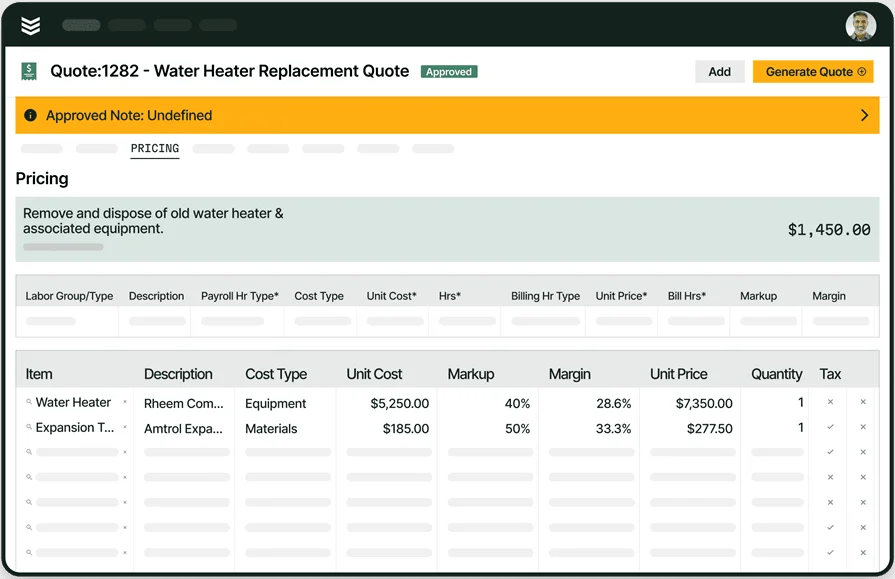
Explore our quoting product
Estimate projects with precision, allowing you to cut costs and boost profits
Other notable features to look for in plumbing flat rate pricing apps
The essentials get your pricing running — but these additional features can sharpen how you manage customers, track performance, and close future work. They're not must-haves for every shop, but if you’re growing or handling higher volume, they’re worth looking for.
- Built-in quoting: Some apps include integrated quoting features that pull directly from your flat rate price book. This cuts down on manual entry and keeps estimates aligned with what’s approved in the field. If you’re managing larger scopes or multi-line jobs, tools like quoting software can help teams move faster and quote more accurately without jumping systems.
- Customer profiles with job and asset history: Having access to past service records, equipment notes, and site-specific pricing can save your team serious time. Apps that connect with a CRM systems let you keep customer context in one place — no digging through spreadsheets or paper files when your techs are on-site.
- Visual dashboards and reporting tools: Tracking how your flat rate pricing performs in the real world helps you make better calls over time. Look for apps with built-in reporting features that surface useful trends — like job profitability, payment timelines, or which services close fastest. Clean visuals go a long way in helping your office stay proactive instead of reactive.
- Support for recurring services and agreements: If you offer maintenance plans or contract-based services, having agreement tools in your pricing app is a bonus. With built-in service agreement software support, you can automate scheduling, lock in agreed-upon rates, and ensure your techs know what’s covered before they even show up.
- Pipeline tracking to stay ahead on quoting: Some apps now include a lightweight sales pipeline feature that shows where each open estimate stands. This helps you follow up faster, spot stalled quotes, and keep the front of your business moving while the field takes care of the rest.
Now that we’ve covered what to look for, let’s break down which plumbing flat rate pricing apps actually deliver — and which ones are better suited for specific types of work.
7 best flat rate pricing apps for plumbing contractors
The best flat rate pricing apps for plumbing contractors vary based on their specific needs, team size, and the complexity and speed of their jobs. The chosen app should facilitate efficient quoting, dispatching, and real-time billing in the field. Here’s a breakdown of top-rated flat rate pricing apps, who they’re best suited for, and what to watch out for when deciding what to use on the job.
1. Best for commercial: BuildOps
BuildOps is designed for commercial plumbing contractors managing fast-paced service teams with complex quoting, scheduling, and billing needs — all from the field. With flat rate pricing embedded directly into mobile workflows, techs can pull up pricing, get approvals, and send invoices right from the app. No more switching between tools or waiting on the office.
How pricing works: BuildOps provides tailored pricing structures determined by the scale and needs of each business. Available for weekly live demos to understand how the platform aligns with your unique operational processes.
Features beyond pricing: BuildOps supports quoting and invoicing directly through its field app. Tools like quoting and invoicing are built into the platform, helping plumbers close jobs in real time. It also includes customer asset tracking, team dispatch boards, job costing visibility, and mobile technician access — all synced to field performance.
What sets it apart for commercial contractors: It’s purpose-built for high-volume teams working across large jobs and multiple techs. The app keeps everyone on the same page with real-time updates, mobile quoting, and pricing accuracy — even as jobs evolve.
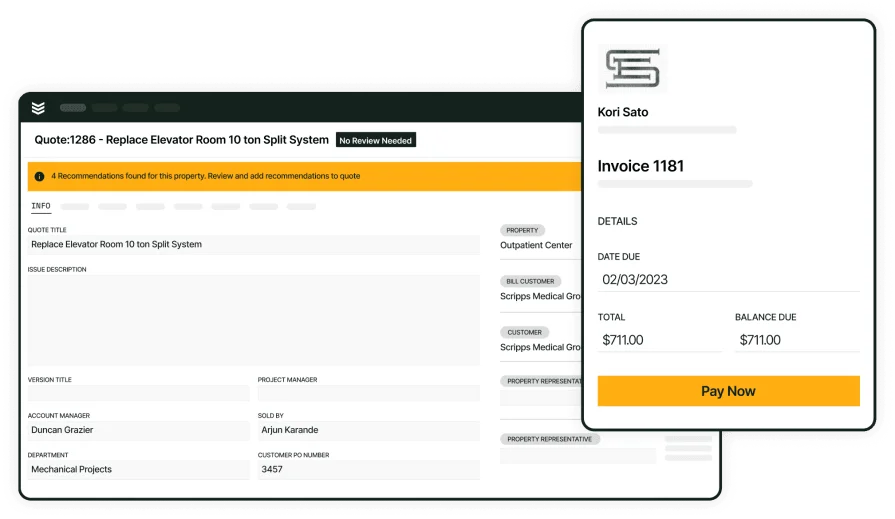
Want to see it in action?
We enable teams to estimate and invoice jobs—all from a single mobile app.
2. Best for residential: Housecall Pro
Image Source: Housecall Pro
Housecall Pro is designed for residential plumbing contractors who need to quote and close jobs quickly from a mobile device. The app gives techs access to flat rate pricing, scheduling, and payment tools right from their phones — making it a solid pick for smaller teams focused on speed and simplicity. However, it may not be the best choice for contractors managing multi-step installs, large teams, or more advanced dispatch workflows.
How pricing works: Subscription plans start around $59/month. Flat rate pricing and quoting tools are included across tiers.
Features beyond pricing: Includes customer texting, job scheduling, GPS tracking, and review generation. Everything is built for quick-turn residential work, making the interface simple and mobile-friendly.
What sets it apart for residential service: It’s made for fast-moving shops that want to quote, schedule, and bill without needing a desktop or back-office help.
3. Best for general contractors: Aptora
Image Source: Aptora
Aptora is a robust flat rate pricing app with a back-end system designed for contractors running plumbing alongside other trades. It gives you full control over how pricing is applied — from service tasks to bundled labor — and supports both cloud and on-premise deployment. That said, Aptora may not be the best fit for plumbing teams that need a mobile-first interface or streamlined setup for field-only workflows.
How pricing works: Pricing is customized by task, material, or labor. Licensing and setup are quote-based.
Features beyond pricing: Includes accounting, payroll, inventory, job costing, and service agreements. It’s a full operating system more than a lightweight mobile app, so it works well for multi-service teams with layered operations.
What sets it apart for general contractors: Ideal for shops managing both plumbing and other trades under one roof — especially those needing deep financial visibility tied to job performance.
4. Best for maintenance-focused shops: ServiceTitan
Image Source: ServiceTitan
ServiceTitan offers a feature-rich platform with flat rate pricing tools aimed at shops that focus heavily on recurring service work. Its app supports memberships, tune-ups, and automated scheduling — making it a smart choice for plumbing contractors with long-term service agreements. Still, its pricing and complexity may be overkill for smaller crews that just want fast, field-based quoting without all the extras.
How pricing works: Flat rate pricing is built into their quoting tools and can be customized by service level. Pricing is tiered based on features and company size.
Features beyond pricing: Includes call booking, marketing automation, service agreement tracking, and reporting dashboards. The mobile app ties these features together, but can require more training to implement effectively.
What sets it apart for maintenance-based work: Great for shops that rely on repeat service visits, memberships, and automation to keep work steady year-round.
5. Best for franchise operations: Service Fusion
Image Source: Service Fusion
Service Fusion is tailored for plumbing companies that operate across multiple locations or franchise models. It includes flat rate pricing tools along with centralized management for teams spread across different markets. However, the interface can feel a bit dated, and it may not be as mobile-optimized as tools built specifically for fast-paced field quoting.
How pricing works: Flat rate pricing can be applied to job templates and service categories. Pricing plans start at approximately $125/month.
Features beyond pricing: Offers centralized customer management, GPS fleet tracking, call scripting, and voice-over-IP integration. Designed to scale with companies that have complex operational setups.
What sets it apart for franchises: Strong admin-level controls and centralized settings make it easier to manage pricing and service consistency across multiple branches.
6. Best for flat pricing rates: FieldEdge
Image Source: FieldEdge
FieldEdge offers flat rate pricing tools with a strong focus on estimating and proposal building. Its app supports real-time quoting, invoice tracking, and parts lookup, making it a solid option for plumbing contractors who want estimating tied directly to service performance. That said, it may not be ideal for contractors looking for deep customization or larger operations needing layered dispatch control.
How pricing works: Flat rate pricing can be tied to estimates and jobs, with syncing across desktop and mobile. Plans are priced by user count and feature access.
Features beyond pricing: Includes dynamic quote generation, service agreement tracking, inventory management, and call booking tools. The app is built with speed and job accuracy in mind, especially at the quoting stage.
What sets it apart for estimating: Great for plumbing teams that rely on fast, accurate field proposals and want their quotes tied tightly to their price book and job performance.
7. Best for small service teams: Jobber
Image Source: Jobber
Jobber is a lightweight, easy-to-use flat rate pricing app geared toward small plumbing businesses. It includes quoting, scheduling, and payment tools inside a simple interface that works well on mobile. However, Jobber may not be the best fit for larger shops that need advanced reporting, multi-team coordination, or commercial-scale workflows.
How pricing works: Flat rate options can be created in job templates or estimates. Pricing plans start around $69/month depending on user needs.
Features beyond pricing: Includes scheduling, client history, one-click invoicing, and online payments. It also offers automated customer follow-ups to help smaller teams stay organized.
What sets it apart for small teams: Easy to learn, fast to launch, and ideal for solo plumbers or small crews handling everyday residential calls.
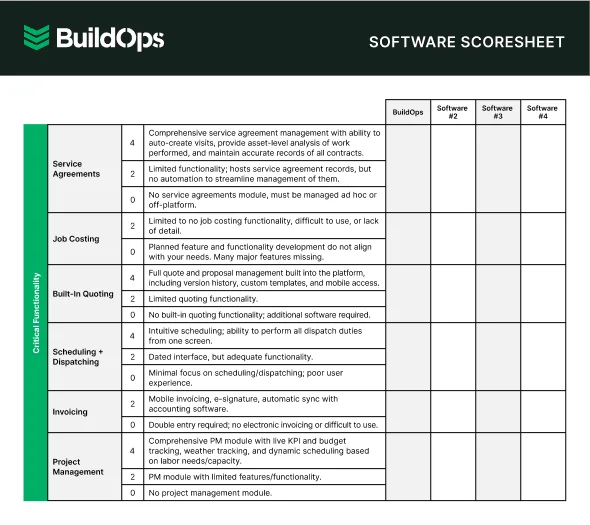
Compare software at a glance
Find the right plumbing estimating software with this easy-to-use scoresheet.
6 benefits of using a flat rate pricing app as a plumber
For plumbers in the field, flat rate pricing apps offer more than just consistency — they simplify quoting, speed up payments, and help crews work smarter without slowing down. Here's what plumbing contractors stand to gain by using these tools daily.
1. Faster, cleaner invoicing
Flat rate pricing apps connect your service work directly to billing. Instead of scribbled notes or double data entry, invoices are auto-filled based on approved tasks and completed work. This keeps paperwork tight and speeds up payment without back-and-forth. If you're standardizing how you bill, tools like a plumbing invoice template can help align what techs do in the app with what goes out to the customer.
2. Fewer callbacks and pricing errors
Preloaded pricing in the app means techs don’t have to second-guess numbers or check with the office mid-job. Every line item has a fixed, approved price — reducing the risk of disputes and giving customers a clear picture upfront. That kind of consistency is why more contractors are turning to flat rate pricing software over handwritten books or disconnected tools.
3. One place for estimates and job completion
Many apps now allow techs to quote a job and invoice it from the same screen. This avoids errors caused by bouncing between platforms or re-entering details later. It's a setup that mirrors what plumbers are already doing in the field, and matches workflows found in estimate-to-invoice apps built specifically for service trades.
4. Better visibility into customer history
Apps that store pricing alongside customer records give your team quick insight into past work — what was done, what was charged, and what equipment’s on site. This is especially useful when tied to a CRM built for plumbers, where service notes, parts usage, and past quotes live under one roof.
5. Real-time pricing adjustments
Not every job goes as planned. When something unexpected comes up — like a cracked pipe behind a wall — your tech needs to adjust the price without halting work. Flat rate apps that allow live edits keep the job moving while protecting your margins. Features like this are part of modern plumbing invoicing workflows that connect field changes directly to final billing.
6. Smoother upselling and service bundling
When techs can show multiple pricing options or upgrade packages from a tablet or phone, upselling becomes part of the job — not a hassle. Many flat rate apps make it easy to toggle between basic, standard, and premium options, helping plumbers present clear value without the pressure. It’s a natural extension of how customers expect to buy today: quick, transparent, and on the spot.
4 common flat rate pricing app FAQs answered for plumbing contractors
Flat rate pricing apps come with a lot of questions — especially for plumbing contractors shifting from paper or spreadsheets to mobile tools. Here’s a breakdown of the most common things plumbers want to know before diving in.
1. What is a flat rate plumbing pricing app?
A plumbing flat rate pricing app is a mobile tool that lets contractors access pre-set service prices, build quotes, and generate invoices — all without calculating time or materials on the job. It replaces paper price books with tap-to-quote tools that speed up work and reduce billing errors.
These apps are built to help field teams stay consistent and accurate, no matter who’s doing the job. Instead of each tech estimating manually, everyone pulls from the same price book. Many apps also tie pricing into dispatch, invoicing, and even customer approvals, streamlining every step of the job.
2. How do flat rate pricing apps for plumbers work?
Flat rate pricing apps work by syncing service prices, labor, and materials into pre-set task templates — all accessible from a mobile device. Once a job is created or dispatched, techs can:
- View preloaded service prices based on the task type
- Select from tiered or bundled pricing options (if supported)
- Generate a quote using mobile tools or templates
- Get customer sign-off directly in the app
- Convert the quote into an invoice without double entry
- Update job notes or flag unexpected changes
- Sync all data back to the office in real time
These tools are designed to be used on-site, keeping the quoting, approval, and billing process connected — even when techs are off Wi-Fi or moving between jobs.
3. Is a flat rate app worth the cost for plumbing contractors?
In most cases — yes. Flat rate pricing apps reduce misquotes, speed up billing, and cut down on callbacks. For shops that run high volume or use multiple techs, the time saved per job quickly offsets the cost. These tools help standardize pricing across your team and protect margins, especially when job scopes shift in the field.
That said, for contractors juggling multiple estimates, recurring work, or complex billing rules, pairing a flat rate pricing app with dedicated estimating or invoicing software brings even more value. Tools that are built for quoting and billing — like those used across field service industries — offer better visibility, approval tracking, and deeper integration with dispatch, CRM, and accounting. While a flat rate app covers the basics, these systems give your office and field teams complete control from quote to payment.
4. Best practices for implementing a flat rate pricing app
Rolling out a flat rate pricing app takes more than just downloading it. These best practices help plumbing teams get the most out of their tool:
- Build a clean, standardized price book first
- Train techs on both quoting and in-app navigation
- Start with basic tasks, then add bundles or tiers later
- Test the app in the field before going live company-wide
- Set clear rules on when techs can adjust pricing
- Make sure dispatch and billing teams understand the workflow
- Enable mobile invoicing to shorten payment cycles
- Collect feedback from your crew during rollout
- Update pricing regularly to reflect labor and material changes
- Track close rates and billing errors to measure impact
Flat rate pricing apps have changed how plumbing contractors quote, bill, and move through jobs — especially in the field. From cutting down callbacks to collecting payment faster, these tools bring serious value to the table when they’re chosen with real job conditions in mind.
But here’s the catch: most apps only cover part of the workflow. They might handle quotes well but fall short on invoicing, dispatch, or real-time updates. The features outlined in this guide — like price-locked work orders, in-app estimating, or synced invoicing — aren’t standard in every platform. And for commercial contractors juggling large crews and evolving job scopes, those gaps become costly.
That’s where an all-in-one field service platform like BuildOps steps in. It’s built specifically for commercial plumbing teams that need their quoting, pricing, scheduling, and billing to work together — not in silos. Everything’s connected, mobile-ready, and made to keep your techs moving, not waiting.
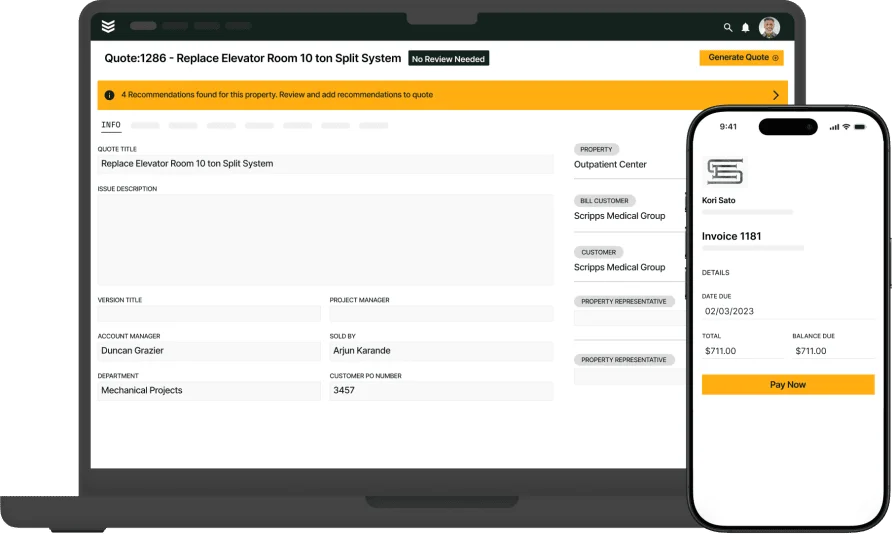
Streamline your plumbing operation
We unify contractor workflows so plumbers can get more work done and boost profits.
